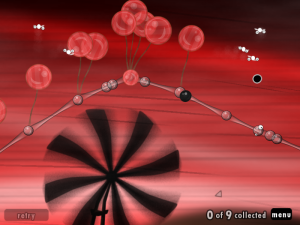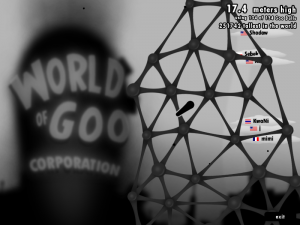Hey all,
The topic of the day is the wonderfully whimsical World of Goo, developed by 2D Boy. I received the game as a part of my extended Humble Bundle #2. Although you can no longer purchase the Humble Bundle #1 or #2, you can head over to their website and sign up to be notified when their next bundle comes out, which I highly recommend. The game is available for purchase on Steam for $10, so if you can fit not eating for a couple of meals you can outfit you personal entertainment device with your very own copy of World of Goo.
But what exactly is World of Goo? And why do I like it?
World of Goo is an indie game where the player connects blobs of goo into shapes to solve environmental puzzles. The puzzles take the form of the old Lemmings games: the critters (in this case, goo blobs) start each level in one place, but want to get to another place. Rescuing the goo blobs requires the player to create a structure leading from their starting position to a magical pipe that will take them to the next level.
Each level has a minimum number of goos that the player must rescue in order to proceed to the next level. If the player rescues more than this minimum number, any extra goos go to the World of Goo Corporation level; which I’ll discuss in just a bit. If you find that a level is too easy, you may also try to go for the gold star: there is also an “OCD number” of goos to rescue, but I don’t know if getting this higher mark conveys any benefits beyond ego-stroking (in exchange for a fair amount of hair-pulling).

Hitting the windmill is bad. Here, the pink balloon goos allow me to make a line above the dangerous obstacle. Which goos the balloons are attached to determines success or gooey mess.
In the way of the goos and their goals are a combination of spinning gears, spikes and chasms, bottomless and otherwise. Gravity is not always your friend either, as goo towers tend to sway back and forth in the breeze. Some of the levels also have wind that will affect how the goo structures react to the environment. There are a number of goo types that the player has access to for overcoming these obstacles: the standard black goos, water goos that can only connect to one other goo, pink balloon goos, green sticky goos that can be moved an unlimited number of times, to name a few. In addition to the goos themselves there are also little critters called “timeflies” that float around on the levels. Clicking on a timefly will set the game back a few seconds, so if the player happens to blow themselves up, crash into a spike, or unbalance a massive tower of goos to their destruction, the player may not have to restart the entire level. It’s a nice feature that helps to limit the amount of pain when dealing with the more complicated puzzles, or puzzles that require a quick reaction time to complete.
I’ve only played through the first two chapters and am now partway through the third, and I have to say the level design is outstanding. The variance in the goos and puzzles is quite wide. So far my favorite level has been “The Red Carpet”, a level which requires two different packs of goos to work together to unroll the red carpet for the princess of beauty’s grand entrance.

The chapter map shows the progression of the goos through the world. Occasionally, the player will have the option to choose one level or another.
The levels are presented through four chapters, plus an epilogue. Each chapter has a distinctive theme in terms of the physics and color schemes.

The World of Goo Corporation sandbox pits the player against other goo-ers around the world. Nowhere to go but up!
The World of Goo Corporation is a special level that is available after the player has saved a few extra goos. Its distinction from the rest of the game is that it is not a mission, but rather a sandbox where the player can experiment with all of their extra goos. The number of goos that the player has in this mode is the cumulative from extra goos of every level that they have completed. Because the land is infinite in all directions,
Artistically, the World of Goo is highly distinct. It has a film-noir feel with colors often muted and dark, or only silhouettes of the world appearing. The colors are bright in the first chapter, with the subsequent chapters becoming more muted. Story isn’t exactly the point of the game, but there is social commentary in there that is told through signs posted throughout the levels, in-game cutscenes, and occasionally animated cinematics. The background music is beautiful and has a nice balance between being intense and being relaxing. My only wish is that I could lower its volume, but that’s a very minor qualm.
Along with the lack of music controls, there are a few other things that I wish could be changed in World of Goo. The worst problem in terms of gameplay is that it can sometimes be hard to put a goo where you want it if the structure that the player is working on is small or tightly packed; trying to move a goo is particularly problematic since goos that have not been locked into the structure yet will move around the structure randomly and it can be difficult to pick up the goo that you want if there are several types of goos there. The statistics from the World of Goo sandbox also take quite a while to update, usually not more than once every 30 seconds or so, which is a bit of a bummer.
But overall these are minor issues that don’t ruin the enjoyment of the game very much, if at all. World of Goo boasts a great physics engine, a fun game world, and well-crafted puzzles; it’s a solid game and highly impressive given that it was created by a team of two. Props to 2D Boy for making such a great game.
Cheers,
-S



Comments